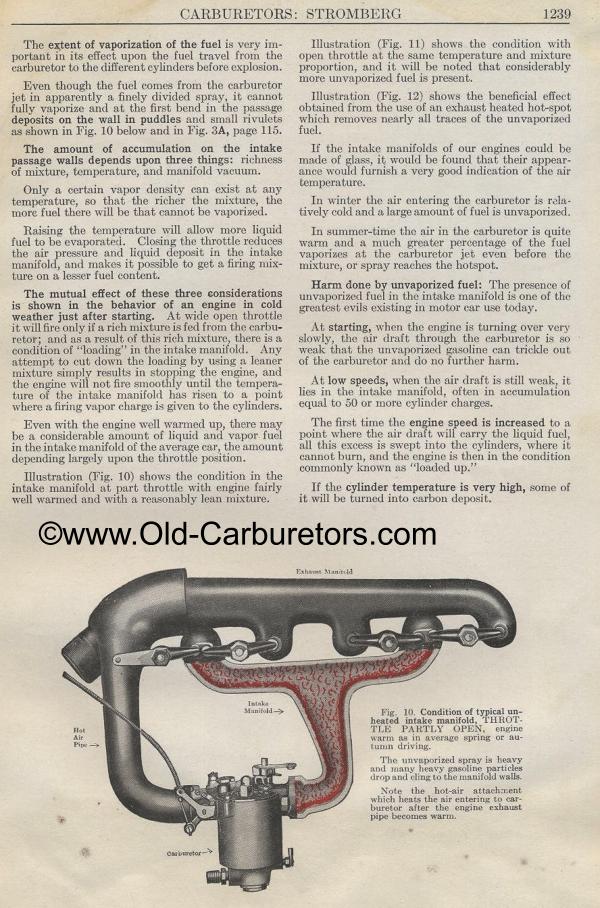STROMBERG
The extent of vaporization of the fuel is very important in its
effect upon the fuel travel from the carburetor to the different
cylinders before explosion.
Even though the fuel comes from the carburetor jet in apparently
a finely divided spray, it cannot fully vaporize and at the first
bend in the passage deposits on the wall in puddles and small rivulets
as shown in Fig. 10 below and in Fig. 3A, page 115.
The amount of accumulation on the intake passage walls depends
upon three things: richness of mixture, temperature, and manifold
vacuum.
Only a certain vapor density can exist at any temperature, so that
the richer the mixture, the more fuel there will be that cannot
be vaporized.
Raising the temperature will allow more liquid fuel to be evaporated.
Closing the throttle reduces the air pressure and liquid deposit
in the intake manifold, and makes it possible to get a firing mixture
on a lesser fuel content.
The mutual effect of these three considerations is shown in the
behavior of an engine in cold weather just after starting. At wide
open throttle i t will fire only if a rich mixture is fed from
the carburetor; and as a result of this rich mixture, there is
a condition of "loading" in the intake manifold. Any
attempt to cut down the loading by using a leaner mixture simply
results in stopping the engine, and the engine will not fire smoothly
until the temperature of the intake manifold has risen to a point
where a firing vapor charge is given to the cylinders.
Even with the engine well warmed up, there may be a considerable
amount of liquid and vapor fuel in the intake manifold of the average
car, the amount depending largely upon the throttle position.
Illustration (Fig. 10) shows the condition in the intake manifold
at part throttle with engine fairly well warmed and with a reasonably
lean mixture.
Illustration (Fig. 11) shows the condition with open throttle at
the same temperature and mixture proportion, and it will be noted
that considerably more unvaporized fuel is present.
Illustration (Fig. 12) shows the beneficial effect obtained from
the use of an exhaust heated hot-spot which removes nearly all
traces of the unvaporized fuel.
If the intake manifolds of our engines could be made of glass,
it would be found that their appearance would furnish a very good
indication of the air temperature.
In winter the air entering the carburetor is relatively cold and
a large amount of fuel is unvaporized.
In summer-time the air in the carburetor is quite warm and a much
greater percentage of the fuel vaporizes at the carburetor jet
even before the mixture, or spray reaches the hotspot.
Harm done by unvaporized fuel: The presence of unvaporized fuel
in the intake manifold is one of the greatest evils existing in
motor car use today.
At starting, when the engine is turning over very slowly, the air
draft through the carburetor is so weak that the unvaporized gasoline
can trickle out of the carburetor and do no further harm.
At low speeds, when the air draft is still weak, it lies in the
intake manifold, often in accumulation equal to 50 or more cylinder
charges.
The first time the engine speed is increased to a point where the
air draft will carry the liquid fuel, all this excess is swept
into the cylinders, where it cannot burn, and the engine is then
in the condition commonly known as "loaded up."
If the cylinder temperature is very high, some of it will be turned
into carbon deposit.
Fig. 10. Condition of typical unheated intake manifold, THROTTLE
PARTLY OPEN, engine warm as in average spring or autumn driving.
The unvaporized spray is heavy and many heavy gasoline particles
drop and cling to the manifold walls.
Note the hot-air attachment which heats the air entering to carburetor
after the engine exhaust pipe becomes warm.
Previous page 1927
Supplement Home Next page 
|
